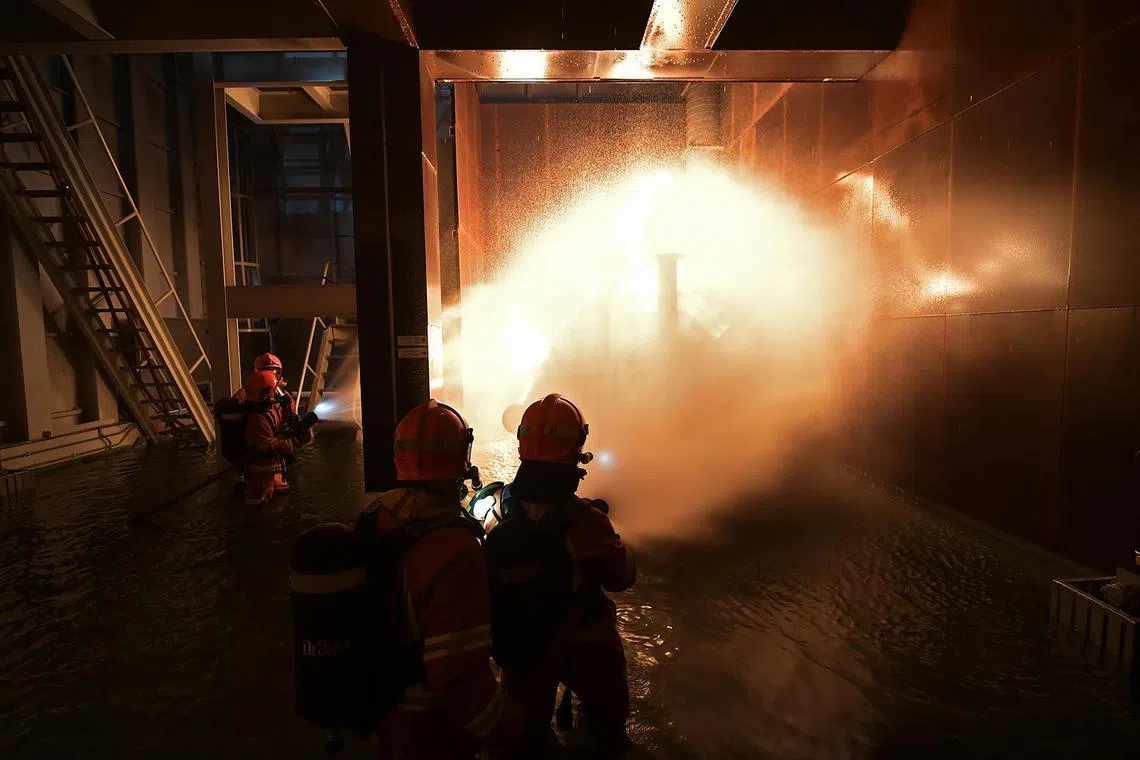Firefighters responding to marine incidents now supported by emergency medical personnel
Sign up now: Get ST's newsletters delivered to your inbox

Marine firefighting teams deployed out at sea include firefighters who are also trained as EMTs.
PHOTO: ST FILE
Follow topic:
SINGAPORE – Firefighters attending to marine incidents are now accompanied by a crew of three emergency medical services (EMS) personnel from fire stations on land.
The temporary protocol, introduced on July 1, is aimed at enhancing operational safety of marine firefighting operations, the Singapore Civil Defence Force (SCDF) said on July 16 in response to queries.
An internal review that was convened following Captain Kenneth Tay Xue Qin’s death while fighting a fire
The EMS crew that is now deployed to support firefighters aboard vessels comprises one paramedic and two emergency medical technicians (EMTs), who will be activated from the nearest land fire station to the incident.
Prior to the interim measure, an EMS crew member would be sent to the nearest landing point, such as a ferry terminal, to stand by after confirmation of a medical emergency that arose from a marine firefighting operation.
There are four levels of medical competency for emergency care, said SCDF.
The first is a first responder, followed by an EMT, a primary care paramedic and an advanced care paramedic.
Marine firefighting teams deployed out at sea include firefighters who are also trained as EMTs. They carry resuscitation equipment, including airway management devices and an automated external defibrillator.
SCDF said it had assembled an internal review group on May 20, comprising its senior officers and experienced marine firefighting specialists, to examine CPT Tay’s final operation from the viewpoint of firefighting strategy, safety procedures, training and equipping.
On May 16, CPT Tay, a 30-year-old marine rota commander at West Coast fire station, lost consciousness while fighting a blaze on board China-flagged tanker Sheng Hang Hua 6. He was taken to hospital, where he was pronounced dead.
In a written parliamentary reply on July 2, Minister for Home Affairs K. Shanmugam had said that all SCDF officers are required to undergo regular medical screening to ensure that they are fit for deployment as firefighters.
He was responding to MP Joan Pereira’s question about whether additional measures will be taken to ensure that firefighters are adequately equipped and trained to protect themselves and their team during firefighting.
“All firefighters are required to undergo firefighting training as part of their foundational course at the Civil Defence Academy before they can be deployed,” said Mr Shanmugam.
“Only those who are certified to be medically fit and are of Physical Employment Status A, B1 or B2 will be deployed because of the physically demanding nature of the job.”
Mr Shanmugam noted that firefighting training includes both theoretical and practical components, such as incident management, firemanship, rescue and use of equipment.
Those selected as marine firefighters undergo further training to equip them with additional skill sets like ship firefighting and search and rescue operations at sea, he said, adding that the specialised training covers knowledge in ship construction and design.
“Marine firefighters are also required to pass the marine firefighting specialist certification test comprising swimming, water rescue, water survival, ship intervention and marine knowledge theory test,” added Mr Shanmugam.


